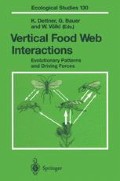Abstract
Arthropod and helminth parasites are classified together as macroparasites on the basis of ecological similarities (Anderson and May 1979). The relationship between each group and its host species for such parameters as ratio of body size, intrinsic population growth rate, life span and the pathological significance of their interaction are comparable but significantly different from microparasites (viruses, bacteria, protozoans) and parasitoids.
Access this chapter
Tax calculation will be finalised at checkout
Purchases are for personal use only
Preview
Unable to display preview. Download preview PDF.
References
Anderson RM, May RM (1979) Population biology of infectious diseases: part 1. Nature 280: 361–367
Andrews RH, Petney TN (1981) Competition for sites of attachment to hosts in three parapatric species of reptile tick. Oecologia 51: 227–232
Andrews RH, Petney TN, Bull CM (1982) Reproductive interference between three parapatric species of reptile tick. Oecologia 52: 281–286
Bull CM, Sharrad RD, Petney TN (1981) Parapatric boundaries between Australian reptile ticks. Proc Ecol Soc Aust 11: 95–107
Bush AO, Holms JC (1986) Intestinal helminths of lesser scaup ducks: an interactive community.Can J Zool 64: 142–152
Demarais S, Jacobson HA, Guynn DA (1987) Effects of season and area on ectoparasites of white-tailed deer(Odocoileus virginianus)in Mississippi. J Wilde Dis 23: 261–266
Dower KD, Petney TN, Horak IG (1988) The relative success of natural infestations of the ticksAmblyomma hebraeumandAmblyomma marmoreumon Leopard Tortoise,Geochelone pardalis. Onderstepoort J Vet Res 55: 11–13
Esch GW, Kennedy CR, Bush AO, Aho JM (1988) Patterns in helminth communities in freshwater fish in Great Britain: alternative strategies for colonization. Parasitology 96: 519–532
Esch GW, Shostak AW, Marcogliase DJ, Goater TM (1990) Patterns and processes in helminth parasite communities: an overview. In: Esch GW, Bush AO, Aho JM (eds) Parasite communities: patterns and processes. Chapman and Hall, London, pp 1–19
Goater TM, Esch GW, Bush AO (1987) Helminth parasites of sympatric salamanders: ecological concepts at infra community, component and compound community levels. Am Midi Nat 118: 289–300
Holmes JC (1987) The structure of helminth communities. Int J Parasitol 17: 203–208
Hoogstraal H, Aeschlimann A (1982) Tick-host specificity. Mitt Schweiz Entomol Ges 55: 5–32
Horak IG, Potgieter FT, Walker JB, de Vos V, Boomker J (1983) The ixodid tick burdens of various large ruminant species in South African nature reserves. Onderstepoort J Vet Res 50: 221–228
Horak IG, Knight MM, Williams EJ (1991a) Parasites of domestic and wild animals in South Africa. XXVIII. Helminth and arthropod parasites of angora goats and kids in valley bush veld. Onderstepoort J Vet Res 58: 253–260
Horak IG, Spickett AM, Braack LEO, Williams EJ (1991b) Parasites of domestic and wild animals in South Africa. XXVII. Ticks on helmeted guinea fowl in the eastern Cape Province and eastern Transvaal lowveld. Onderstepoort J Vet Res 58: 137–143
Kaiser MN, Sutherst RW, Bourne AS (1982) Relationship between ticks and zebu cattle in southern Uganda. Trop Anim Health Prod 14: 63–74
Keirans JE, Walker JB, Horak IG, Heyne H (1993)Rhipicephalus exophthalmus sp. nov., a new tick species from southern Africa, and a redescription ofRhipicephalus oculatus Neumann, 1901, with which it has hitherto been confused (Acari: Ixodida: Ixodidae). Onderstepoort J Vet Res 60:229-246
Maclvor KM, Horak IG, Holton KC, Petney TN (1987) An evaluation of live and destructive sampling techniques to determine parasitic tick populations. Exp Appi Acarol 3: 131–143
Norval RAI (1977) Studies on the ecology ofAmblyomma hebraeumKoch in the eastern Cape Province of South Africa. II. Survival and development. J Parasitol 63: 740–747
Norval RAI, Short N (1984) Interspecific competition betweenBoophilus decoloratusandBoophilus microplusin southern Africa. In: Griffiths DA, Bowman CE (eds) Acarology IV, vol 2. Ellis Horwood, Chichester, pp 1242–1246
Norval RAI, Andrew HR, Yunker CE (1989) Pheromone mediation of host selection in the bonttick(Amblyomma hebraeumKoch). Science 243: 364–365
Petney TN, Horak IG (1987) The effect of dipping on parasitic and free-living populations ofAmblyomma hebraeumon a farm and on an adjacent nature reserve. Onderstepoort J Vet Res 54: 529–533
Petney TN, van Ark H, Spickett AM (1989) On sampling tick populations: the problem of overdispersion. Onderstepoort J Vet Res 57: 123–127
Ribeiro JMC, Makoul GT, Levine L, Robinson DR, Spielman A (1985) Antihemostatic, antiinflammatory and immunosuppressive properties of the saliva of the tick,Ixodes dammini. J Exp Med 161: 332–344
Schulze BR (1972) South Africa. In: Griffiths JF (ed) Climates of Africa, vol 10. World survey of climatology. Elsevier, Amsterdam, pp 501–586
Smithers RHN (1983) The mammals of the southern African subregion. University of Pretoria, Pretoria, xxii + 736 pp
Walker JB (1991) A review of the ixodid ticks (Acari, Ixodidae) occurring in southern Africa. Onderstepoort J Vet Res 58: 81–105
Editor information
Editors and Affiliations
Rights and permissions
Copyright information
© 1997 Springer-Verlag Berlin Heidelberg
About this chapter
Cite this chapter
Petney, T.N., Horak, I.G. (1997). The Community Structure of Ticks on Kudu, Tragelaphus strepsiceros, in the Eastern Cape Province of South Africa. In: Dettner, K., Bauer, G., Völkl, W. (eds) Vertical Food Web Interactions. Ecological Studies, vol 130. Springer, Berlin, Heidelberg. https://doi.org/10.1007/978-3-642-60725-7_6
Download citation
DOI: https://doi.org/10.1007/978-3-642-60725-7_6
Publisher Name: Springer, Berlin, Heidelberg
Print ISBN: 978-3-642-64528-0
Online ISBN: 978-3-642-60725-7
eBook Packages: Springer Book Archive

